El Salvador
- Nicaragua - Costa Rica - Panama
A quick glance across these predominantly white former Spanish colonies might
suggest a basic commonality of culture and language and traditions in the
region. To my surprise, each of these Central American republics exhibited
wildly different characters, from dialect down to fundamental values. Despite
the small size of these nations, locals rarely cross the borders and have
little first hand knowledge of how life goes on for their neighbours. In
some cases, this results in exaggerated stereotypes, such as the pervasive
Costa Rican perception of darker skinned Nica (Nicaraguan) immigrants and
labourers as the singular source of crime and savagery in their country.
In some cases, jealousies are created, such as the Nicaraguan envy of Costa
Rican peace and stability or Guatemalan envy of El Salvador’s rapid economic
development in the past decade. Land ownership disputes provoked a series
of "soccer wars" between El Salvador and Honduras that still leaves bitter
feelings. Costa Rica and Panama, by far the wealthiest nations in the region,
would seem to be natural trade and exchange partners, are surprisingly ignorant
of each other, though there appears to be no feeling of resentment or rivalry
on either side of their frontier. Observing such cultural interactions and
contrasts benefits greatly from visiting the entire region on a single overland
trip and this proved to be one of the greatest satisfactions to me personally.
In my opinion, the greatest triumph of Central America today is that every
nation is a sovereign democracy, creating a contiguous democratic zone stretching
from the Arctic down to French Guiana. Many people still associate with Central
America the image of banana republics run by corrupt generalissimos fighting
for either J. Edgar Hoover or Fidel Castro or even God himself. Throughout
most of the 1980s and much of the 1990s, Guatemala, El Salvador, and Nicaragua
were embroiled in bloody, seemingly endless civil wars where hope was distant
and dreams of a simple life were just that, dreams. Well, now the hope is
there and Central Americans can at least begin to dream, even though most
of them still live in very poor conditions. War impedes all progress, and
suffrage breeds self-empowerment, so I am optimistic about the future of
this region. There still exist temptations to slip back into chaos, but so
far they have been resisted. Guatemalans toiled and suffered through the
entire elected rule of a shamelessly and openly corrupt president (Alfonso
Portillo) before voting him out. Panama has just orchestrated its first peaceful,
democratic handover of power since the US military overthrow of Manuel "Pineapple-face"
Noriega. The same could have been said of Vicente Fox’s election as president
of Mexico a few years ago, ending decades of single-party rule. El Salvador
and Nicaragua have both organized free and fair elections in recent months,
and the latter has just won access to significant sums of aid grant money
for development from the United States government. That such a dramatic transition
from banana republics to upstanding democracies, warts and all, could have
taken place in recent years without even so much as a nod from international
media (usuallyl more interested in wars and global political intrigue) is
a tremendous testament to the humble but indomitable will of the Central
American people to work hard for peace and development.
And let me just put in this plug to voice my opinion on a common contentious
coffeehouse topic vis a vis Central America. The United States (and the Soviet
Union and Cuba as well) fully deserves to be exposed and judged for its covert
Cold War machinations interfering in internal Central American affairs, ignoring
completely the needs of struggling local peasants in favour of geopolitical
priorities. On the other hand, the United States has also played a
pivotal role in stabilizing the volatile region politically and economically
since the end of the Cold War, and deserves its share of credit for that
as well. This is not a selfless act, as stability pays rewards to the United
States as well, but welcome in a region that had grown more used to seeing
Kalashnikov and M-16 rifles than to seeing new shopping centres opened and
roads paved. Slow and (hopefully) sustainable, development may not be as
headline-worthy as CIA coups d'etat or rebels in the jungle reciting Che
Guevara passages, but I'd bet that most ordinary folks there would reaffirm
the adage that no news is good news. I didn't realize before this trip how
intimately the Central american economies and well-being are tied to the
United States, in every way. Bidirectional trade flows not just in tropical
fruits, but in labour, financial services, petrol refining, ecotourism, forestry,
heavy machinery, textiles, among many other products and services. Much of
the capital fueling current day development comes from remittances sent to
families by their relatives working in El Norte, whose service economy depends
in great part on immigrant labourers (legal and illegal) willing to work
jobs that others won't. The values of the Central American currencies fluctuate
hand in hand with el dolar. The synergy between the economies is obviously
more critical for the well-being of Central America than for the United States,
but stability benefits everybody. Empires are built one person at a time,
shop by shop, road by road. Tolstoy's novel Anna Karenina opens, "All happy
families resemble each other. Each unhappy family is unhappy in its own way."
The same may eventually apply to the Central American republics.
El Salvador
Nowhere is the power of remittances more tangible than in El Salvador, a
poor nation wracked by an extended civil war, followed by Hurricane Mitch
in 1998, followed by a disastrous earthquake in 2001 that left thousands
of dead and injured and three-quarters of a million homeless in a country
of six million people. While the personal tragedies can never be reversed,
Salvadorans have made exemplary use of the diaster relief funds that arrived
in the wake of the disasters. The rebuilt highways and roads are the best
I saw in Central America, and frankly, better than most in the first world.
New commercial and residential complexes are springing up all over San Salvador.
Corruption has been minimal, facilitating the flow of capital to infrastructure
projects, and this has already started paying dividends. El Salvador has
the fastest growth rate in Central America and has turned heads in the world
economic community. Apart from incoming capital from remittances, Salvadorans
who'd fled the civil war have been returning from the United States, bringing
their dollars with them. I was told that up to a quarter of Salvadorans during
the period of the civil war had lived in the US at some point. Perhaps this
explains why the new San Salvador looks and feels so American, right down
to the curbs, traffic signs, donut shops and strip malls.
Few outsiders have witnessed the resurrection of El Salvador. There is virtually
no tourism in the country, by far and away the least visited in Central America.
There are no really impressive ruins or heritage sites. There are no cute
colonial towns. There is only one distinct Salvadoran artistic style, and
many artisanal products for sale are imported or copied from neighbouring
countries. Virtually all of the backpackers whose paths I crossed had darted
around El Salvador through Honduras, and I might have done the same if I
hadn't planned to visit in San Salvador the sister of a friend who works
in the diplomatic community, and who showed me around during my weekend in
transit. We visited the El Imposible national park, where the most impossible
part of it may have been in successfully finding the back entrance to get
in. It is a pleasant highlands park with some wild animals in a nation with
severe deforestation problems, but nothing phenomenal.

A odd looking fruit apparently only found in El Salvador.
Not supposed to be very tasty but hey it looks cool.
Though the tourist buzz surrounding El Salvador is virtually nil, the two
backpackers I met who did venture in El Salvador absolutely loved their experience.
Salvadorans, despite their hardships, are the friendliest people in Central
America. It seemed to me be a sincere, straightforward and unconditional
warmth. Because the tourist infrastructure is not quite in place yet, there
is no competition for access to beaches or lodging. Apparently, it wasn't
so long ago that you could have had an entire Pacific coast beach to yourself.
The major drawback to visiting the country is its pricetag. Food and lodging
are quite expensive for a nation of its wealth, perhaps due to the limited
supply of tourist facilities.
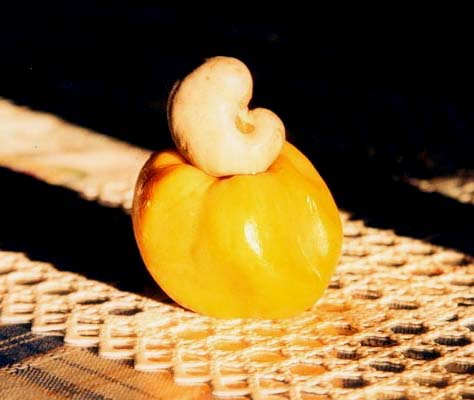
The marano, or fruit of the cashew nut, is found all over Central
America. They seem to like it down there, but it was far too astringent
for me.
Nicaragua
For most people, the name Nicaragua conjures up images of civil war, the
Somoza dictatorship, Sandinistas and Contras. Some people are aware of Lake
Nicaragua, largest saltwater lake in the world, and a handful of history
buffs may remember that original plans to build a canal bridging the lake
to the flanking oceans were later dropped in favour of another propitious
site in Panama. But beyond this, it is quite amazing how little anybody really
knows about this fairly sizeable Central American nation. The heavily geopoliticized
war was protracted, but probably no more horrific than the Guatemalan civil
war which encompassed human slaughters and ethnic cleansing. In its wake,
political mood swings and sweeping changes in government have delayed progress
in getting the country back on its feet. The capital Managua still looks
like a destroyed metal siding shantytown. The extensive wartime deforestation
and consequent desertification may unfortunately be an irreversible process.
Nicaraguans generally appear weary, short-tempered and cranky, whether because
of their problems or by their culture. They don't take no guff from anyone.
Guatemalans have a similar reputation but are not quite as brusque as Nicaraguans,
perhaps because they have more exposure to tourists. Stories of armed robbery
and rape are not uncommon. In short, Nicaragua feels like a wild, rough and
ready frontierland, your quintissential banana republic where anything can
happen at any moment.
But perhaps therein lies its charm. Nicaragua doesn't hide its rough edges,
doesn't try to sweet-talk you, and looks you square in the eyes. I was eventually
won over by this forthright sincerity and interesting atmosphere. Oh, it's
not where you'd take the kids on holiday or send gramps and gramma to retire,
but for the independent traveller, there are many rewards. And it's not a
secret anymore for those in backpacking circles. Some young travellers plan
Nicaragua as the focal point of their central american tour. It's probably
the cheapest country in which I've travelled in Latin America. The beaches
are not overrun by tourists, the waves are reportedly great for surfing,
the virtually unknown colonial towns are as dazzlingly beautiful as any other
in the region, and transportation is quick and efficient, if crowded. Riding
a city bus across Managua during rush hour to get from one bus terminal to
another may be the most crowded experience I've ever endured (and I'm writing
this passage now after having visited India). I couldn't get out of the bus
when I saw my stop, and the surly Nicaraguan passengers made not the slightest
effort to help the foreigner get off. I eventually had to physically and
literally push my way through dozens of people to get off, two stops later.
But that is normal life there.
I'm going to say this right now: Granada, Nicaragua may be the most beautiful
city in Central America, by any standards. On this trip, the only other colonial
cities in the same class that I visited were Antigua (Guatemala), Guanajuato,
and Campeche (Mexico). This centrepiece of Nicaraguan tourism is in perfect
condition. The dominant blue and green pastel shades of Granada offer a pleasant
contrast to the predominant red and yellow hues of Antigua. Its site beneath
an active volcano and on the northern shore of Lake Nicaragua is hard to
beat. Granada is the only Nicaraguan city with a well developed tourist infrastructure
and I was surprised by how many tourists, both the adventurous and the grouped-masses
variety, were already there. I consider myself a well informed world traveller,
but I had no idea that this was such a gem of a city.
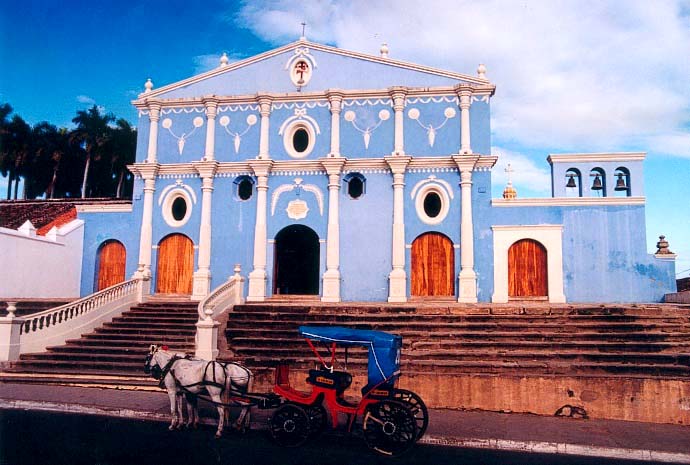
Believe me or not, but all of Granada, Nicaragua is as delightful
as the San Francisco church just a block northwest of the plaza central.
The "other" major colonial city in Nicaragua is Leon, reputed for his political
and intellectual activism. It's a bigger city than Granada, but not nearly
as colourful or pretty overall. There are very few tourists in Leon and it
has the grittiness of a city that functions, rather than a city that preens
in the mirror. Still, its churches are second to none. I've put up some photos
of churches for you to get an idea of the eleganceof colonial architecture
in Leon and Nicaragua in general.
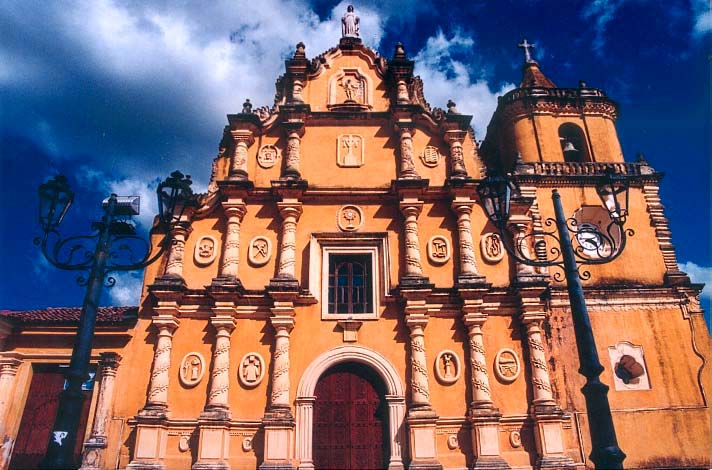
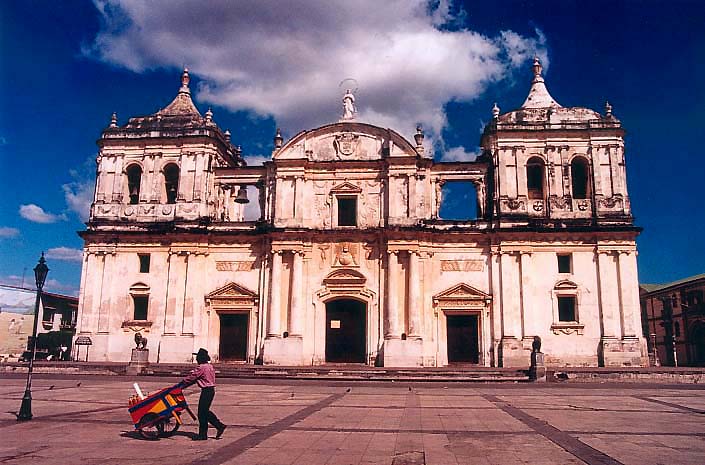

Three churches in Leon, Nicaragua. From top to bottom, la
Recolecction, la Catedral, and El Calvario.
After Leon I looped back to Granada in order to take a boat to Costa Rica,
across Lake Nicaragua. It's more common to take a bus from Granada to San
Jose, Costa Rica along the Carretera interamericana that runs down the continent
not far from the Pacific Ocean. However, I was aiming to reach the secluded
Caño Negro national park in Costa Rica, which is situated on the Nicaraguan
border and closer to the Carribean coast, well removed from the main highway.
For this trajectory, the 12 hour overnight ferry boat ride across the lake
was more efficient and undoubtedly more pleasant. Conditions on the main
deck of the boat were horribly crowded with locals and their produce and
their livestock, leaving virtually no space for them to lie down on the hard
floor. Fortunately, a first-class cabin on the upper deck is available and
all but the most cash-strapped tourists avail themselves to this much more
comfortable compartment with air conditioning, security watchman, and padded
bench seating. I had a pleasant time chatting with a retired Wisconsin couple
and after they got off the boat at Ometepe island, I spent most of the night
chatting with a Massachusetts girl who was just about to finish her three
year stint with the Peace Corps in Nicaragua (and very happy to be finishing).
The ferry arrived into the port of San Carlos early in the morning and I
spent a few hours milling about in this small and dusty Nicaraguan village
while awaiting the daily motorboat sailing to Los Chiles, Costa Rica. Since
this is an international cruise, passport formalities need to be undertaken
on both ends. The Nicaraguan end was easy enough, but the Costa Rican bureaucracy
required long waits because of strict immigration controls on incoming Nicaraguan
labourers, for whom Costa Ricans have a deep mistrust. Though I was very
groggy from not having slept enough on the overnight ferry, the hour long
lancha passage down the Rio Frio was a thrilling experience. Wildlife abounded
along the riverbanks. Two species of monkeys, white-faced and howlers, cavorted
about from tree to tree. A family of turtles darted underwater from their
rocky stools. A crocodile lounged on the riverside under a shade tree. All
manner of colourful water birds, for which this tropical jungle area is famous,
flitted over and around us. I didn't realize until later on this trip that
this would be the densest concentration of wildlife that I'd see anywhere
in Central America.
Costa Rica
My high school friend Bill and his mom were waiting for me in Cafe del Parque
in Los Chiles, exactly as we had planned in advance. They had just flown
into Costa Rica from San Diego a couple of nights earlier and woke up before
6 am to catch two different buses making the passage from Alajuela, in the
central highlands of Costa Rica, all the way out to the lost corner of Los
Chiles in the eastern Carribean lowlands. Meanwhile I had floated across
Lake Nicaragua, across the Costa Rican border, and upstream through the Rio
Frio to meet them at the preset rendezvous point. Our last contact had been
by e-mail when they were in San Diego and I was in Granada, so fortunately
nothing went awry in the meantime. We hired a boat at the Los Chiles docks
to take a cruise along the Rio Frio toward the Caño Negro reserve
and the wildlife was much the same as on the Nicaraguan side of the river,
with the addition of a sloth sighting. The preserved park areas of the two
countries are vast and abut along the border in this remote region. Exploring
the backwater channels feeding into the Rio Frio was interesting for the
change in vegetation and trees, and everywhere you see brightly coloured
kingfishers and other tropical birds. We stayed the night at a fleabag hotel
in Los Chiles and left town by bus early the next morning.
Because time was limited, we decided to head straight toward the Arenal volcano
and the Monteverde cloud forest rather than back to our base in Alajuela,
where we could stay in a house owned by Bill's relatives. The tourist hub
of Fortuna sits under Arenal, one of the most active volcanoes in the world.
Unfortunately at that time of year, cloud cover is common and indeed we did
not see any of the fire spewing out of Arenal. Fortuna is very touristy and
quite expensive, as all tourist hubs in Costa Rica turned out to be. Costa
Rica has become rich from ecotourism and the predominant clients are Americans
who select this destination nation because of its security, hygiene, infrastructure,
and convenience. Everything that a package tourist is looking for exists
in Costa Rica and really nowhere else in Central America. For the backpacker,
this translates to high prices, unnecessary conveniences, relatively poor
public transportation, and quite a shock coming in from Nicaragua. The sterility
of the hotel rooms may be correlated with the sterility of Costa Rican life.
Apart from the tropical forests, there is really very little of note about
the very homogeneous culture. Costa Ricans are friendly, quick to smile and
start up a conversation, but by the end of my stay there, I started wondering
about their sincerity. Other travellers had warned me that locals are much
more interested in sizing you up to making some colones off of you, rather
than actually curious about you, and I found myself in agreement with this
evaluation. Money plays a peculiar role in the culture, and there seems to
be little trust between people there when money comes into play, whether
it's between client and vendor, between offices of the same company, or even
between members of a family. Everything is personal, which can make administrative
bureaucracy rather daunting unless one understands the system and the individuals
involved. There are no street numbers or names. A typical address might read
"75m south of the San Francisco church." Costa Ricans are particularly community
and family-minded, with relatively little concern about domains outside of
their immediate surroundings. It is not a simple culture to understand fully,
certainly more complex than their friendly Tico (nickname for Costa Ricans)
image.
The two other Costa Rican natural parks that we visited, Monteverde and Corcovado,
are among the most prestigious parks in Central America. Costa Rica is well
known for its extensive conservation policies, and deservedly so. About a
quarter of the country's surface area is protected parkland, and this investment
in greenery proved to be a prescient boon to the economy. No country in the
world is as admired or studied in the business of ecotourism as Costa Rica.
This, along with the impressive lack of wars in the 20th century, has propelled
their standard of living far above the Central American average. Only Panama
is at a comparable level, but Costa Rica doesn't have its own cash cow canal
or a developed financial services sector as Panama does, so the wealth appears
to be more evenly distributed.
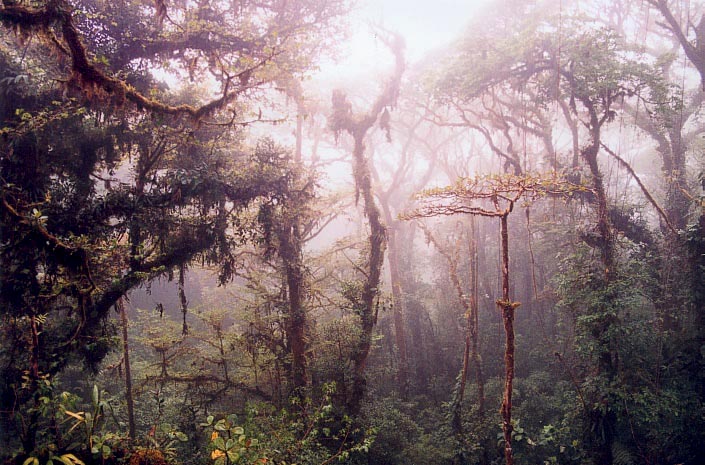
The Monteverde Cloud Forest sits high above sea level and indeed felt very
cool compared to the sweltering lowlands. The cloud forest itself was very
lovely, an ecosystem harboring vegetation and wildlife distinct from lowland
jungles. The ropey vines dangling from scraggly tree branches and scrubby
brush on the ground reminded me of intermediate-elevation forests on the
climb up Mount Kilimanjaro. Bone-chilling clouds rolled through the exposed
areas of the forest, leaving behind a photogenic haze. A zipline ride that
we had taken the previous day (costing more than my entire expenses in Nicaragua)
passed through a similar cloud forest, and sent us screaming through low-level
clouds through the valleys at high speed. Monteverde is also known for harbouring
a distinct class of cloud forest animals, but we saw virtually nothing. Even
birds weren't easy to come by. We eventually did spot the "resplendent" and
"elusive" quetzal, truly one of the rarest and most beautiful birds in the
world, by tagging along behind groups led by park guides, and that was quite
satisfying. But on the whole, it is not an exaggeration to say that we saw
more wildlife by the parking lot outside of the park than during half a day
of walking inside the park.
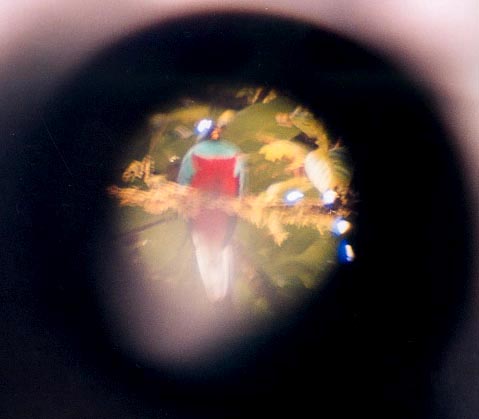
The Monteverde cloud forest (above) and a picture of the elusive
quetzal (below) taken by placing my camera over the eyepiece of a birdwatching
telescope and stabilizing it by hand.
Corcovado is a true lowland tropical park on the southern Pacific coast corner
of Costa Rica. National Geographic anointed it "the most biologically intense
place on Earth," so naturally we were hyped up about all the animals we'd
see during three days of hiking through the sticky, bug-infested jungle.
Just about all we saw, though, was a species of bipedal hominids with opposable
thumbs commonly seen all over the world. Again, like Monteverde, the forest
flora itself was lush and lovely, but we were terribly disappointed by the
lack of fauna after our high expectations. I saw more wild animals in Guatemala
than I did in Costa Rica, which leads me to believe that Costa Rica does
a very fine job of marketing itself to attract foreign tourists. We covered
50 km of trail along beaches, through the jungle, and finally back out of
the Corcovado jungle through a different path. In the heart of the park,
we stayed at a primitive lodge that was way overpriced, perhaps to pump money
out of foreign visitors despite pricing out local tourists, and found the
staff there to be largely apathetic and unfriendly. The most unexpected and
interesting part of the hike was on the last day, when the trail followed
a river upstream to lead out of the park. We ended up having to ford this
same shallow river 24 times before we reached the nearest town.
If Nicaragua was one of the most pleasant surprises I had in Central America,
Costa Rica was clearly the biggest disappointment. I doubt that many of the
tourists who visit Costa Rican parks and rave about them when they return
home have made any serious effort to explore what some of the other Central
American countries have to offer (and for far, far less money) in the way
of sights and experiences, though admittedly they can't compete on the level
of tourist infrastructure. Costa Rica has clearly reached the critical mass
for a self-sustaining tourism industry, where word of mouth will be sufficient
to keep new visitors coming. I do hope, however, that some of the poorer
but no less deserving nations in the region will be able to attract their
fair share of tourist money as well.
Panama
Before my trip I knew virtually nothing about Panama apart from the canal
and their recent political history. Then by the time I was making my way
down through Central America, I started to suspect that Panama might be a
less-touristy version of Costa Rica with beaches and a similar European heritage.
I was woefully wrong on all counts except the less-touristy part. Panama
was a dynamic, vivacious, ethnically mixed cauldron bubbling with a colourful
culture and its own peculiar traditions. In short, it was one of my favourite
countries in the region, and if I was forced to live the rest of my life
in one Central American country, it would probably be in Panama, for its
high standard of living, its lowkey but honestly friendly people, and institutions
that work. Before arriving, I had heard from experienced travellers that
Panama beats Costa Rica in every way, and though I was skeptical upon hearing
it, now I see why. There's nothing in Costa Rica that you can't find in Panama,
whether it's beaches, jungle, good weather, wildlife, or nightlife. Well,
I guess volcanoes would be one exception where Costa Rica clearly wins, but
you get the point. If there is little discussion around the world about tourism
in Panama, it is in great part due to the Panamian government which has done
virtually nothing to promote tourism. This was even a sidelight campaign
issue in the recent presidential election, where the incumbent president
Moscoso lost her reelection bid.
Panama city is the Manhattan of central America, the financial bridge between
North America and South America, with towering skyscrapers and modern commercial
facilities. However, the financial district is just one of many neighbourhoods
in the capital. The central hotel and government area is a bit seedy but
alive and pulsing. A long pedestrian commercial street, leading from this
neighbourhood out to the old town, is packed until sundown. The Casco Viejo
or Casco Antiguo, the old colonial neighbourhood, is known more familiarly
to locals as the San Felipe quarter. The rundown buildings are in generally
poor condition, the residents are among the poorest in Panama city, and it
is reputed as the most dangerous corner of the city, but it is an astonishingly
beautiful colonial town. The old town encompasses the entirety of the original
colonial city under Spanish rule. It reminded me of Havana's old town, in
both the scale of its ambitions and crumbling colonial ruins. A well-funded
urban redevelopment project to rehabilitate the neighbourhood would be an
excellent investment and tourists would come over time.
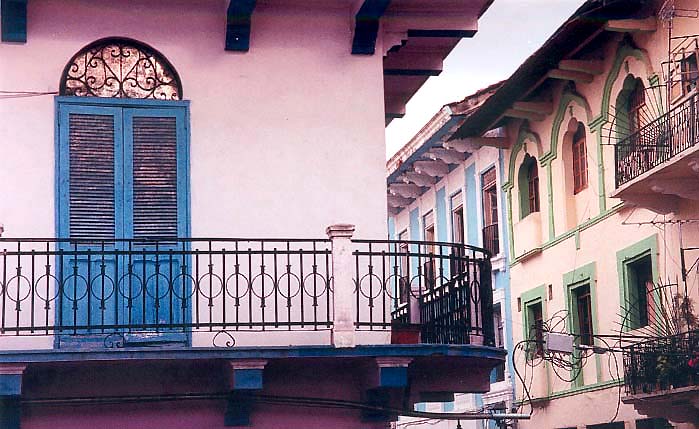
The sublime old San Felipe district of Panama City was the original
Spanish colonial settlement, but in most parts not nearly as well preserved
as these buildings.
We chose to our week in Panama to coincide with Carnaval time, as Panama
is reputed to hold the biggest and best shows in Central America. Panama
city itself ran some floats with costumed actors on Mardi Gras night, but
it wasn't the most heart-pounding spectacle you'll ever see. It felt more
like an obligation on the part of the city to "do" Carnaval. The same apathy
can in no way be attributed to the small traditional towns on the Azuero
peninsula of Panama. They live, breathe and die Carnaval and other festivals
with an intense personal passion that I'd wager surpasses Rio de Janeiro
or New Orleans. All of the local families it seems actively participate in
the realisation of their day and night shows, and joining in with them are
hordes of Panamanians, and some other tourists (though they are limited by
the hotel space available in the region), who swell the population of the
town tenfold, or maybe more. The streets swarm with festive Carnavalers and
on special occasions during the five day event, local women step out into
town wearing polleras, a lovely traditional Azuero dress carefully made by
hand. The expense and complexity of these dresses reminded me of traditional
kimonos worn on New Year's day in Japan. Carnaval in the Azuero town
of Las Tablas, the most renowned of the Panamian Carnavals, is another dimension
altogether and deserves its own page to itself.
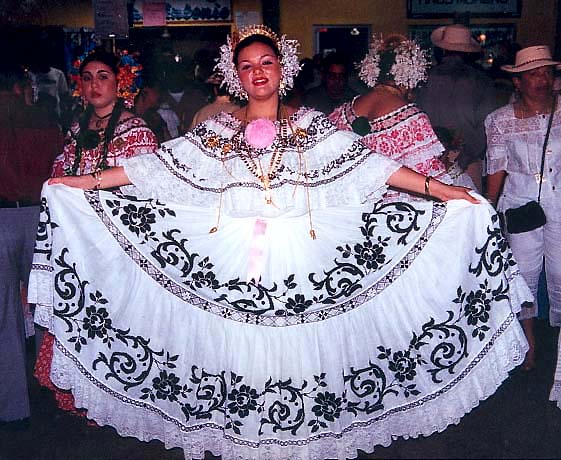
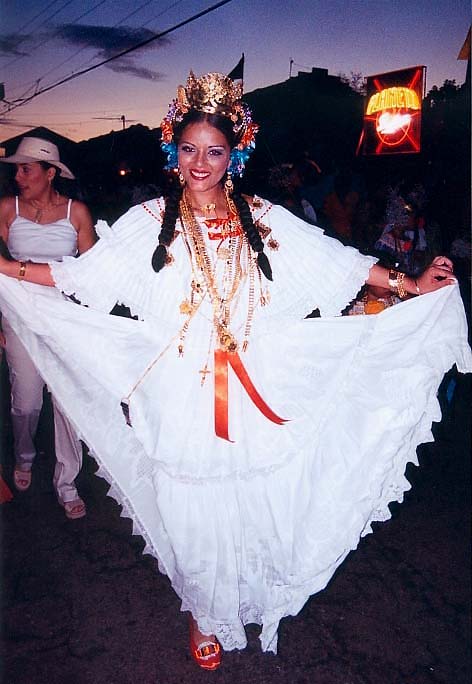
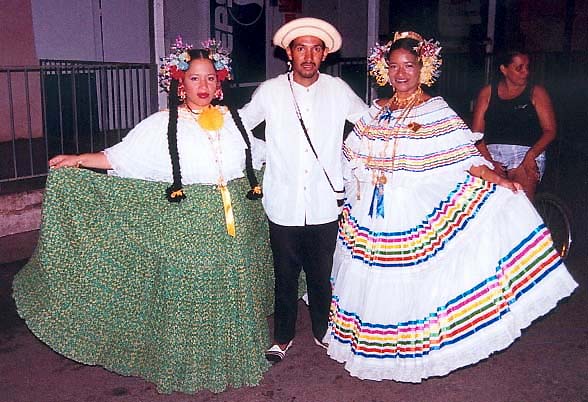
At Carnaval time, Panamians come out in traditional handmade costumes,
including the Spanish-inspired pollera dresses. Pictured here are residents
of Villa de Los Santos, Azuero peninsula, Panama.
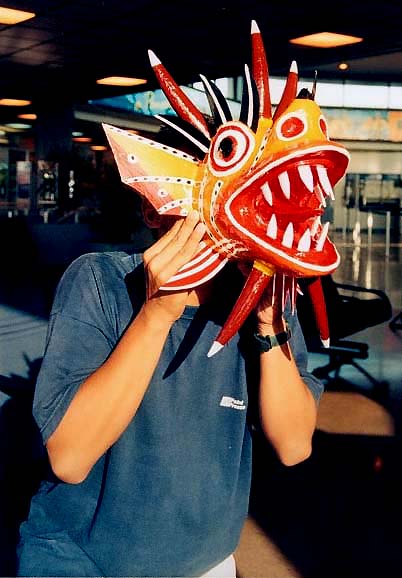
Festival mask making is another tradition still alive and well
in Panama, as I demonstrate here in Panama's Tocumen airport. We visited
the home of the notable mask maker Dario Lopez, in Parita, Panama on the
Azuero peninsula, and I walked out with a few of his handicrafts, including
this Corpus Christi festival mask made of papier-mache.












